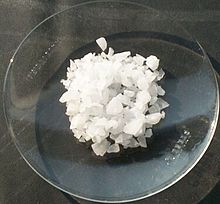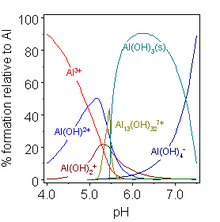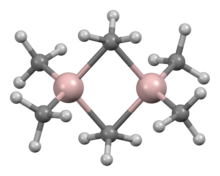Aluminium compounds

Aluminium(BritishandIUPACspellings) or aluminum (North American spelling) combines characteristics of pre- and post-transition metals. Since it has few available electrons for metallic bonding, like its heavier group 13 congeners, it has the characteristic physical properties of a post-transition metal, with longer-than-expected interatomic distances.[1]Furthermore, as Al3+is a small and highly charged cation, it is strongly polarizing andaluminium compoundstend towards covalency;[2]this behaviour is similar to that ofberyllium(Be2+), an example of adiagonal relationship.[3]However, unlike all other post-transition metals, the underlying core under aluminium's valence shell is that of the precedingnoble gas,whereas for gallium and indium it is that of the preceding noble gas plus a filled d-subshell, and for thallium and nihonium it is that of the preceding noble gas plus filled d- and f-subshells. Hence, aluminium does not suffer the effects of incomplete shielding of valence electrons by inner electrons from the nucleus that its heavier congeners do. Aluminium's electropositive behavior, high affinity for oxygen, and highly negativestandard electrode potentialare all more similar to those ofscandium,yttrium,lanthanum,andactinium,which have ds2configurations of three valence electrons outside a noble gas core: aluminium is the most electropositive metal in its group.[1]Aluminium also bears minor similarities to the metalloid boron in the same group; AlX3compounds are valenceisoelectronicto BX3compounds (they have the same valence electronic structure), and both behave asLewis acidsand readily formadducts.[4]Additionally, one of the main motifs of boron chemistry isregular icosahedralstructures, and aluminium forms an important part of many icosahedralquasicrystalalloys, including the Al–Zn–Mg class.[5]
Reactions of aluminium
[edit]Aluminium reacts with most nonmetals upon heating, forming compounds such asaluminium nitride(AlN), aluminium sulfide (Al2S3), and the aluminium halides (AlX3). It also forms a wide range ofintermetallic compoundsinvolving metals from every group on the periodic table. Aluminium has a highchemical affinityto oxygen, which renders it suitable for use as areducing agentin thethermitereaction. A fine powder of aluminium reacts explosively on contact withliquid oxygen;under normal conditions, however, aluminium forms a thin oxide layer that protects the metal from further corrosion by oxygen, water, or dilute acid, a process termedpassivation.[2][6]This layer is destroyed by contact withmercurydue toamalgamationor with salts of some electropositive metals.[2]As such, the strongest aluminium alloys are less corrosion-resistant due togalvanicreactions with alloyedcopper,[7]and aluminium's corrosion resistance is greatly reduced by aqueous salts, particularly in the presence of dissimilar metals.[1]In addition, although the reaction of aluminium with water at temperatures below 280 °C is of interest for the production of hydrogen, commercial application of this fact has challenges in circumventing the passivating oxide layer, which inhibits the reaction, and in storing the energy required to regenerate the aluminium.[8]
Primarily because it is corroded by dissolvedchlorides,such as commonsodium chloride,household plumbing is never made from aluminium.[9]However, because of its general resistance to corrosion, aluminium is one of the few metals that retains silvery reflectance in finely powdered form, making it an important component ofsilver-coloredpaints. Aluminium mirror finish has the highestreflectanceof any metal in the 200–400 nm (UV) and the 3,000–10,000 nm (farIR) regions; in the 400–700 nm visible range it is slightly outperformed bytinandsilverand in the 700–3000 nm (near IR) by silver,gold,andcopper.[10]
In hot concentratedhydrochloric acid,aluminium reacts with water with evolution of hydrogen, and in aqueoussodium hydroxideorpotassium hydroxideat room temperature to formaluminates—protective passivation under these conditions is negligible.[9]The reaction with aqueous alkali is often written:[2]
- Al + NaOH + H2O → NaAlO2+3/2H2
although the aluminium species in solution is probably instead the hydrated tetrahydroxoaluminate anion, [Al(OH)4]−or [Al(H2O)2(OH)4]−.[2]
Oxidizing acids do not effectively attack high-purity aluminium because the oxide layer forms and protects the metal;aqua regiawill nevertheless dissolve aluminium. This allows aluminium to be used to store reagents such asnitric acid,concentratedsulfuric acid,and some organic acids.[11]
Inorganic compounds
[edit]The vast majority of compounds, including all aluminium-containing minerals and all commercially significant aluminium compounds, feature aluminium in the oxidation state 3+. Thecoordination numberof such compounds varies, but generally Al3+is either six- or four-coordinate. Almost all compounds of aluminium(III) are colorless.[2]

In aqueous solution, Al3+exists as the hexaaqua cation [Al(H2O)6]3+,which has an approximatepKaof 10−5.[13]Such solutions are acidic as this cation can act as a proton donor, progressivelyhydrolysingto [Al(H2O)5(OH)]2+,[Al(H2O)4(OH)2]+,and so on. As pH increases these mononuclear species begin to aggregate together by the formation of hydroxide bridges,[2]forming many oligomeric ions, such as theKeggin ion[Al13O4(OH)24(H2O)12]7+.[13]The process ends with precipitation ofaluminium hydroxide,Al(OH)3.This is useful forclarificationof water, as the precipitate nucleates onsuspendedparticles in the water, hence removing them. Increasing the pH even further leads to the hydroxide dissolving again asaluminate,[Al(H2O)2(OH)4]−,is formed. Aluminium hydroxide forms both salts and aluminates and dissolves in acid and alkali, as well as on fusion with acidic and basic oxides:[2]
- Al2O3+ 3 SiO2Al2(SiO3)3
- Al2O3+ CaOCa(AlO2)2
This behaviour of Al(OH)3is termedamphoterism,and is characteristic of weakly basic cations that form insoluble hydroxides and whose hydrated species can also donate their protons. Further examples include Be2+,Zn2+,Ga3+,Sn2+,and Pb2+;indeed, gallium in the same group is slightly more acidic than aluminium. One effect of this is that aluminium salts with weak acids are hydrolysed in water to the aquated hydroxide and the corresponding nonmetal hydride:aluminium sulfideyieldshydrogen sulfide,aluminium nitrideyieldsammonia,andaluminium carbideyieldsmethane.Aluminium cyanide,acetate,andcarbonateexist in aqueous solution but are unstable as such; only incomplete hydrolysis takes place for salts with strong acids, such as the halides,nitrate,andsulfate.For similar reasons, anhydrous aluminium salts cannot be made by heating their "hydrates": hydrated aluminium chloride is in fact not AlCl3·6H2O but [Al(H2O)6]Cl3,and the Al–O bonds are so strong that heating is not sufficient to break them and form Al–Cl bonds instead:[2]
- 2[Al(H2O)6]Cl3Al2O3+ 6 HCl + 9 H2O
All fourtrihalidesare well known. Unlike the structures of the three heavier trihalides,aluminium fluoride(AlF3) features six-coordinate aluminium, which explains its involatility and insolubility as well as highheat of formation.Each aluminium atom is surrounded by six fluorine atoms in a distortedoctahedralarrangement, with each fluorine atom being shared between the corners of two octahedra in a structure related to but distorted from that ofReO3.Such {AlF6} units also exist in complex fluorides such ascryolite,Na3AlF6,but should not be considered as [AlF6]3−complex anions as the Al–F bonds are not significantly different in type from the other M–F bonds.[14]Such differences in coordination between the fluorides and heavier halides are not unusual, occurring in SnIVand BiIIIas well for example; even bigger differences occur betweenCO2andSiO2.[14]AlF3melts at 1,290 °C (2,354 °F) and is made by reaction ofaluminium oxidewithhydrogen fluoridegas at 700 °C (1,292 °F).[14]

With heavier halides, the coordination numbers are lower. The other trihalides aredimericorpolymericwith tetrahedral four-coordinate aluminium centers.Aluminium trichloride(AlCl3) has a layered polymeric structure below its melting point of 192.4 °C (378 °F), but transforms on melting to Al2Cl6dimers with a concomitant increase in volume by 85% and a near-total loss of electrical conductivity. These still predominate in the gas phase at low temperatures (150–200 °C), but at higher temperatures increasingly dissociate into trigonal planar AlCl3monomers similar to the structure ofBCl3.Aluminium tribromideandaluminium triiodideform Al2X6dimers in all three phases and hence do not show such significant changes of properties upon phase change.[14]These materials are prepared by treating aluminium with the halogen. The aluminium trihalides form manyaddition compoundsor complexes; theirLewis acidicnature makes them useful as catalysts for theFriedel–Crafts reactions.Aluminium trichloride has major industrial uses involving this reaction, such as in the manufacture ofanthraquinonesandstyrene;it is also often used as the precursor for many other aluminium compounds and as a reagent for converting nonmetal fluorides into the corresponding chlorides (atranshalogenation reaction).[14]
- AlCl3+ 3 LiZ → 3 LiCl + AlZ3(Z = R, NR2,N=CR2)
- AlCl3+ 4 LiZ → 3 LiCl + LiAlZ4(Z = R, NR2,N=CR2,H)
- BF3+ AlCl3→ AlF3+ BCl3
Aluminium forms one stable oxide with thechemical formulaAl2O3,commonly calledalumina.[15]It can be found in nature in the mineralcorundum,α-alumina;[16]there is also a γ-alumina phase.[13]As corundum is very hard (Mohs hardness9), has a high melting point of 2,045 °C (3,713 °F), has very low volatility, is chemically inert, and a good electrical insulator, it is often used in abrasives (such as toothpaste), as a refractory material, and in ceramics, as well as being the starting material for the electrolytic production of aluminium.Sapphireandrubyare impure corundum contaminated with trace amounts of other metals.[13]The two main oxide-hydroxides, AlO(OH), areboehmiteanddiaspore.There are three main trihydroxides:bayerite,gibbsite,andnordstrandite,which differ in their crystalline structure (polymorphs). Many other intermediate and related structures are also known.[13]Most are produced from ores by a variety of wet processes using acid and base. Heating the hydroxides leads to formation of corundum. These materials are of central importance to the production of aluminium and are themselves extremely useful. Some mixed oxide phases are also very useful, such asspinel(MgAl2O4), Na-β-alumina (NaAl11O17), andtricalcium aluminate(Ca3Al2O6,an important mineral phase inPortland cement).[13]
The only stablechalcogenidesunder normal conditions arealuminium sulfide(Al2S3),selenide(Al2Se3), andtelluride(Al2Te3). All three are prepared by direct reaction of their elements at about 1,000 °C (1,832 °F) and quickly hydrolyse completely in water to yield aluminium hydroxide and the respectivehydrogen chalcogenide.As aluminium is a small atom relative to these chalcogens, these have four-coordinate tetrahedral aluminium with various polymorphs having structures related towurtzite,with two-thirds of the possible metal sites occupied either in an orderly (α) or random (β) fashion; the sulfide also has a γ form related to γ-alumina, and an unusual high-temperature hexagonal form where half the aluminium atoms have tetrahedral four-coordination and the other half have trigonal bipyramidal five-coordination.[17]Fourpnictides,aluminium nitride(AlN),aluminium phosphide(AlP),aluminium arsenide(AlAs), andaluminium antimonide(AlSb), are known. They are allIII-V semiconductorsisoelectronic tosiliconandgermanium,all of which but AlN have thezinc blendestructure. All four can be made by high-temperature (and possibly high-pressure) direct reaction of their component elements.[17]
Rarer oxidation states
[edit]Although the great majority of aluminium compounds feature Al3+centers, compounds with lower oxidation states are known and are sometimes of significance as precursors to the Al3+species.
Aluminium(I)
[edit]AlF, AlCl, AlBr, andAlIexist in the gaseous phase when the respective trihalide is heated with aluminium, and at cryogenic temperatures. Their instability in the condensed phase is due to their readydisproportionationto aluminium and the respective trihalide: the reverse reaction is favored at high temperature (although even then they are still short-lived), explaining why AlF3is more volatile when heated in the presence of aluminium, as is aluminium when heated in the presence of AlCl3.[14]
A stable derivative of aluminium monoiodide is the cyclicadductformed withtriethylamine,Al4I4(NEt3)4.Also of theoretical interest but only of fleeting existence are Al2O and Al2S. Al2O is made by heating the normal oxide, Al2O3,with silicon at 1,800 °C (3,272 °F) in avacuum.Such materials quickly disproportionate to the starting materials.[18]
Aluminium(II)
[edit]Very simple Al(II) compounds are invoked or observed in the reactions of Al metal with oxidants. For example,aluminium monoxide,AlO, has been detected in the gas phase after explosion[19]and in stellar absorption spectra.[20]More thoroughly investigated are compounds of the formula R4Al2which contain an Al–Al bond and where R is a large organicligand.[21]
Organoaluminium compounds and related hydrides
[edit]
A variety of compounds of empirical formula AlR3and AlR1.5Cl1.5exist.[22]The aluminium trialkyls and triaryls are reactive, volatile, and colorless liquids or low-melting solids. They catch fire spontaneously in air and react with water, thus necessitating precautions when handling them. They often form dimers, unlike their boron analogues, but this tendency diminishes for branched-chain alkyls (e.g.Pri,Bui,Me3CCH2); for example,triisobutylaluminiumexists as an equilibrium mixture of the monomer and dimer.[23][24]These dimers, such astrimethylaluminium(Al2Me6), usually feature tetrahedral Al centers formed by dimerization with some alkyl group bridging between both aluminium atoms. They arehard acidsand react readily with ligands, forming adducts. In industry, they are mostly used in alkene insertion reactions, as discovered byKarl Ziegler,most importantly in "growth reactions" that form long-chain unbranched primary alkenes and alcohols, and in the low-pressure polymerization ofetheneandpropene.There are also someheterocyclicand cluster organoaluminium compounds involving Al–N bonds.[23]
The industrially most important aluminium hydride islithium aluminium hydride(LiAlH4), which is used in as a reducing agent inorganic chemistry.It can be produced fromlithium hydrideandaluminium trichloride:[25]
- 4 LiH + AlCl3→ LiAlH4+ 3 LiCl
The simplest hydride,aluminium hydrideor alane, is not as important. It is a polymer with the formula (AlH3)n,in contrast to the corresponding boron hydride that is a dimer with the formula (BH3)2.[25]
References
[edit]- ^abcGreenwood and Earnshaw, pp. 222–4
- ^abcdefghiGreenwood and Earnshaw, pp. 224–7
- ^Greenwood and Earnshaw, pp. 112–3
- ^King, p. 241
- ^King, pp. 235–6
- ^Vargel, Christian (2004) [French edition published 1999].Corrosion of Aluminium.Elsevier.ISBN978-0-08-044495-6.Archivedfrom the original on 21 May 2016.
- ^Polmear, I.J. (1995).Light Alloys: Metallurgy of the Light Metals(3 ed.).Butterworth-Heinemann.ISBN978-0-340-63207-9.
- ^"Reaction of Aluminum with Water to Produce Hydrogen"(PDF).U.S. Department of Energy. 1 January 2008. Archived fromthe original(PDF)on 14 September 2012.
- ^abBeal, Roy E. (1999).Engine Coolant Testing: Fourth Volume.ASTM International. p. 90.ISBN978-0-8031-2610-7.Archivedfrom the original on 24 April 2016.
- ^Macleod, H.A. (2001).Thin-film optical filters.CRC Press. p. 158159.ISBN978-0-7503-0688-1.
- ^Frank, W.B. (2009). "Aluminum".Ullmann's Encyclopedia of Industrial Chemistry.Wiley-VCH.doi:10.1002/14356007.a01_459.pub2.ISBN978-3-527-30673-2.
- ^*Baes, C.F.; Mesmer, R.E. (1986) [1976].The Hydrolysis of Cations.Malabar, FL: Robert E. Krieger.ISBN978-0-89874-892-5.
- ^abcdefGreenwood and Earnshaw, pp. 242–52
- ^abcdefGreenwood and Earnshaw, pp. 233–7
- ^Eastaugh, Nicholas; Walsh, Valentine; Chaplin, Tracey; Siddall, Ruth (2008).Pigment Compendium.Routledge.ISBN978-1-136-37393-0.
- ^Roscoe, Henry Enfield; Schorlemmer, Carl (1913).A treatise on chemistry.Macmillan. p.718.
Aluminium forms one stable oxide, known by its mineral name corundum.
- ^abGreenwood and Earnshaw, pp. 252–7
- ^Dohmeier, C.; Loos, D.; Schnöckel, H. (1996). "Aluminum(I) and Gallium(I) Compounds: Syntheses, Structures, and Reactions".Angewandte Chemie International Edition.35(2): 129–149.doi:10.1002/anie.199601291.
- ^Tyte, D.C. (1964). "Red (B2Π–A2σ) Band System of Aluminium Monoxide".Nature.202(4930): 383–384.Bibcode:1964Natur.202..383T.doi:10.1038/202383a0.S2CID4163250.
- ^Merrill, P.W.; Deutsch, A.J.; Keenan, P.C. (1962). "Absorption Spectra of M-Type Mira Variables".The Astrophysical Journal.136:21.Bibcode:1962ApJ...136...21M.doi:10.1086/147348.
- ^Uhl, W. (2004). "Organoelement Compounds Possessing Al–Al, Ga–Ga, In–In, and Tl–Tl Single Bonds".Organoelement Compounds Possessing Al–Al, Ga–Ga, In–In, and Tl–Tl Single Bonds.Advances in Organometallic Chemistry. Vol. 51. pp. 53–108.doi:10.1016/S0065-3055(03)51002-4.ISBN978-0-12-031151-4.
- ^Elschenbroich, C. (2006).Organometallics.Wiley-VCH.ISBN978-3-527-29390-2.
- ^abGreenwood and Earnshaw, pp. 257–67
- ^Martin B. Smith, Journal of Organometallic Chemistry, The Monomer-Dimer Equilibria of Liquid Ammonium Alkyls II Triisobutylaluminum Journal of Organometallic Chemistry, Volume 22, Issue 2, April 1970, Pages 273-281.doi:10.1016/S0022-328X(00)86043-X
- ^abGreenwood and Earnshaw, pp. 227–32
Bibliography
[edit]- Greenwood, Norman N.;Earnshaw, Alan (1997).Chemistry of the Elements(2nd ed.).Butterworth-Heinemann.ISBN978-0-08-037941-8.
